Solid State SATA Modules and Form Factors
 Over the past several years, the storage interface for embedded flash storage applications has seen a migration from the IDE/ATA interface to lower pin count and in many cases faster SD/MMC and SATA interface devices.
Over the past several years, the storage interface for embedded flash storage applications has seen a migration from the IDE/ATA interface to lower pin count and in many cases faster SD/MMC and SATA interface devices.
To address the physical size, ruggedness and performance requirements of diverse applications, several form factors have emerged in both the SD/MMC and SATA space. In this post, we examine various form factors popular in SATA interface solid state storage devices.
The Serial ATA International Organization (SATA-IO) defines three main SATA interface revisions:
SATA I – 1.5 Gbits/sec (150 Mbytes/sec)
- Original spec revision released January 7, 2003
- Does not support Native Command Queuing (NCQ)
SATA II – 3.0 Gbits/sec (300 Mbytes/sec)
- Does not support Native Command Queuing (NCQ)
- Backward compatible with SATA I – 1.5 Gbits/sec
SATA III – 6.0 Gbits/sec (600 Mbytes/sec)
- Supports Native Command Queuing (NCQ)
- Backward compatible with SATA I – 3.0 Gbits/sec
mSATA (Mini-SATA; MO-300) Form Factor
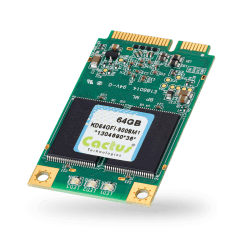 The Mini-SATA (typically referred to as mSATA) is a small form factor SATA interface device used in commercial applications such as netbooks and laptops as well as embedded systems for industrial applications.
The Mini-SATA (typically referred to as mSATA) is a small form factor SATA interface device used in commercial applications such as netbooks and laptops as well as embedded systems for industrial applications.
- Physical size: 50.8mm x 29.85mm
- Connector type: 52-pin card edge connector (split into 16-pin & 36-pin sections)
The SATA IO Group first announced mSATA on September 21, 2009 and JEDEC published a comprehensive SSD standard of MO-300 defining the mSATA SSD assembly in January 2010. While mSATA has the same form factor as Mini PCI Express Cards, designs may or may not support both product types.
Cactus offers both an Industrial Grade mSATA based on SLC NAND and a Industrial MLC mSATA based on MLC NAND.
Slim SATA (Half Slim SATA; MO-297) Form Factor
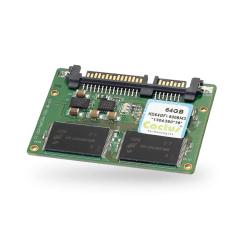 The Slim SATA (also referred to as Half Slim SATA) is a small form factor SATA interface device used in commercial applications such as netbooks and laptops as well as embedded systems for industrial applications.
The Slim SATA (also referred to as Half Slim SATA) is a small form factor SATA interface device used in commercial applications such as netbooks and laptops as well as embedded systems for industrial applications.
- Physical size: 39.8mm x 54mm
- Connector type: 22-pin standard 2.5” SATA SSD connector
JEDEC published the MO-297 defining the Slim SATA SSD assembly in May 2009 which adheres to the SATA-IO Groups electrical specifications. The Slim SATA uses the same 22-pin SATA connector as 2.5” SATA SSD allowing designers to use existing cabling for embedded applications.
Cactus offers both an Industrial Grade Slim SATA based on SLC NAND and a Industrial MLC Slim SATA based on MLC NAND.
CFast Card Form Factor (defined by CompactFlash Association)
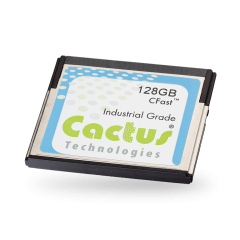 The CFast card is a little different than the other modules. It was defined by the CompactFlash Association (CFA) as a faster alternative to Compact Flash cards. It has been gaining popularity lately in embedded systems for industrial applications.
The CFast card is a little different than the other modules. It was defined by the CompactFlash Association (CFA) as a faster alternative to Compact Flash cards. It has been gaining popularity lately in embedded systems for industrial applications.
- Physical size: 36.4mm x 42.8mm x 3.3mm
- Connector type: CFast specific 24-pin female connector
CFast adheres to the SATA-IO Groups electrical specifications. CFast cards have a 24-pin female connector in the same location as Compact Flash's 50-pin connector, but it is not in any way compatible with CompactFlash. An OEM needs to design a specific socket onto his board to use the CFast card form factor.
Cactus offers both an Industrial Grade CFast based on SLC NAND and a Industrial MLC CFast based on MLC NAND.
2.5" SATA SSD (Solid State Drive) Form Factor
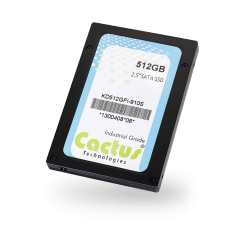 The 2.5” SATA SSD is a solid state storage device mainly aimed at replacing existing rotating hard disk drives (HDD) in host systems. Solid State Drives have not only the same 22-pin SATA connector as HDD, but they also have the same form factor and mounting holes.
The 2.5” SATA SSD is a solid state storage device mainly aimed at replacing existing rotating hard disk drives (HDD) in host systems. Solid State Drives have not only the same 22-pin SATA connector as HDD, but they also have the same form factor and mounting holes.
- Physical size: 100.5mm x 69.85mm x 9.5mm (height can vary by manufacturer)
- Connector type: 22-pin standard 2.5” SATA connector
2.5” SATA SSD adhere to the SATA-IO Groups electrical specifications and are seen by the host system the same as HDD. The benefit for designers in both commercial and industrial application environments is ease of design.
Cactus offers Industrial Grade 2.5” SATA II SSD and Industrial SATA III SSD based on SLC NAND as well as Industrial MLC 2.5” SATA II SSD and SATA III SSD based on MLC NAND.
M.2 - Next Generation Form Factor (NGFF)
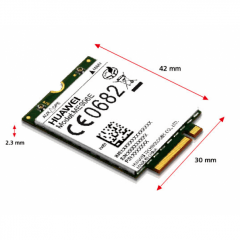 The M.2 form factor (originally referred to as NGFF – Next Generation Form Factor) is a very small SATA module targeted at ultrabooks and tablets. It is a flexible form factor in that there are several different widths and lengths of PCB specified and many different functions in addition to solid state memory supported.
The M.2 form factor (originally referred to as NGFF – Next Generation Form Factor) is a very small SATA module targeted at ultrabooks and tablets. It is a flexible form factor in that there are several different widths and lengths of PCB specified and many different functions in addition to solid state memory supported.
- Physical size: 22mm x 30mm (typical, although spec allows for many widths/lengths)
- Connector type: up to 67-pin card edge connector
M.2 was defined by the SATA-IO Group. It is extremely popular in the latest consumer electronics devices.
Cactus does not offer the M.2 solid state storage as a standard product, but would welcome a discussion regarding your requirements.






